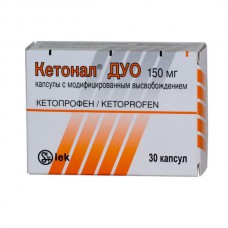Expiration date: 06/2026
The composition and form of issue:
Capsules with modified release of 1 caps.
the core of the pellets
active substance:
Ketoprofen 150 mg
other ingredients: microcrystalline cellulose lactose monohydrate povidone croscarmellose sodium Polysorbate 80
shell pellets: Eudragit RS 30D (ethylacrylate, methyl methacrylate and a copolymer trimetilammoniietilakrilata [1:2:0, 1]) Eudragit RL 30D (ethylacrylate, methyl methacrylate and a copolymer trimetilammoniietilakrilata [1:2:0, 2]) triethylcitrate Polysorbate 80 talc iron (III) oxide yellow (E172) silica colloidal anhydrous
the composition of the capsule shell: gelatin Indigo Carmine (E132) titanium dioxide (E171)
in blister 10 capsules in a pack of cardboard blisters 2 or 3.
Description of dosage form:
Capsule No. 1 with a transparent body and a blue cap.
The contents of the capsule are white and yellow pellets.
Pharmacokinetics:
Have Ketonal DUO is a new pharmaceutical form, different from conventional capsules in the way of release of active agent. Modified release capsules contain two types of pellets, white (about 60% of the total) and yellow (coated). Ketoprofen is rapidly released from white pellets and slowly from yellow, which causes a combination of rapid and prolonged action of the drug.
The drug is well absorbed after oral administration. Bioavailability of both conventional and modified release capsules is the same at 90%. Eating does not affect the overall bioavailability (AUC) of Ketoprofen, but reduces the rate of absorption.
After oral administration of Ketoprofen in the form of capsules with a modified release of 150 mg plasma Cmax 9036, 64 ng / ml is achieved within 1, 76 hours.
Distribution. Ketoprofen is 99% bound with blood plasma proteins, predominantly albumin fraction. Vd in tissues is 0, 1-0, 2 l/kg.the Drug penetrates well into the synovial fluid and reaches a concentration equal to 30% plasma. Significant concentrations of Ketoprofen in synovial fluid are stable and remain up to 30 h, resulting in a long time decreases pain and stiffness of the joints.
Metabolism and excretion. Ketoprofen undergoes extensive metabolism through the microsomal enzymes of the liver, T1/2 of Ketoprofen at least 2 hours, It binds to glucuronic acid and excreted as glucuronide. There are no active metabolites of Ketoprofen.
Up to 80% is excreted by the kidneys, mainly (more than 90%) in the form of glucuronide Ketoprofen, and about 10% — through the intestine.
In patients with hepatic insufficiency, the plasma concentration of Ketoprofen increased by 2 times (probably due to hypoalbuminemia and consequently — a high level of unrelated active Ketoprofen), such patients need to prescribe the drug in a minimum therapeutic dose.
In patients with renal insufficiency, clearance of Ketoprofen is reduced, which also requires correction of the doses.
In elderly patients, the metabolism and excretion of Ketoprofen occur more slowly, but this is clinically important only for patients with reduced renal function.
Description of the pharmacological action:
Ketoprofen is a NSAID that possesses anti-inflammatory, analgesic and antipyretic activity. Due to the inhibition of COX-1 and COX-2 and, in part, lipoxygenase; Ketoprofen inhibits the synthesis of PG and bradykinin, stabilizes lysosomal membranes. Ketoprofen has no negative effect on the condition of articular cartilage.
Indications:
Symptomatic therapy of painful and inflammatory processes of different origin, including:
- inflammatory and degenerative diseases of the musculoskeletal system: rheumatoid arthritis seronegative arthritis — ankylosing spondylitis (Bechterew's disease), psoriatic arthritis, reactive arthritis (Reiter's syndrome) gout, pseudogout osteoarthritis
- pain syndrome: headache, tendonitis, bursitis, myalgia, neuralgia, sciatica, post-traumatic and postoperative pain syndrome pain syndrome in cancer algomenorrhea.
Contraindications:
- hypersensitivity to Ketoprofen or other components of the drug, as well as salicylates or other NSAIDs
- bronchial asthma, rhinitis or history of urticaria caused by acetylsalicylic acid or other NSAIDs
- peptic ulcer of the stomach or duodenum in the stage of exacerbation
- nonspecific ulcerative colitis, Crohn's disease in the exacerbation phase, inflammatory bowel diseases in the exacerbation stage
- hemophilia and other blood clotting disorders
- children's age (up to 15 years)
- severe hepatic insufficiency
- expressed renal failure, progressive kidney disease
- uncompensated heart failure
- postoperative period after coronary artery bypass grafting
- gastrointestinal, cerebrovascular and other bleeding (or suspected bleeding))
- chronic dyspepsia
- III trimester of pregnancy, lactation.
Caution: peptic ulcer disease history of asthma history of symptomatic cardiovascular, cerebrovascular disease and peripheral artery disease dyslipidemia progressive liver disease hyperbilirubinemia alcoholism renal failure chronic heart failure hypertension blood disorders dehydration diabetes mellitus, anamnestic data about the development of ulcerative shock syndrome Smoking concomitant therapy with anticoagulants (e.g. warfarin), antiplatelet agents (e.g. acetylsalicylic acid), oral corticosteroids (e.g. prednisone), SSRIs (e.g. citalopram, sertralin), long-term use of NSAIDs.
Application during pregnancy and breast-feeding:
The use of Ketoprofen in the third trimester of pregnancy is contraindicated. In the first and second trimesters of pregnancy, the appointment of the drug is possible only if the intended benefit to the mother exceeds the potential risk to the fetus.
When taking the drug during lactation should resolve the issue of termination of breastfeeding.
Side effect:
The incidence of side effects is characterized as very common (>10%), common (>1%, <10%), non-proliferation (>0, 1%, <1%), rare (>0, 01%, <0, 1%) and very rare (<0, 01%).
Allergic reactions: common-skin reactions (itching, urticaria) are non — proliferation-rhinitis, shortness of breath, bronchospasm, angioedema, anaphylactoid reactions.
Digestive system: common-dyspepsia (nausea, diarrhea or constipation, flatulence, vomiting, decreased or increased appetite), abdominal pain, stomatitis, dry mouth, non — proliferation (with prolonged use in large doses) — ulceration of the gastrointestinal mucosa, liver dysfunction rare-perforation of the digestive tract, exacerbation of Crohn's disease, melanoma, gastrointestinal bleeding.
CNS: common-headache, dizziness, sleep disturbance, fatigue, nervousness, nightmares rare — migraine, peripheral polyneuropathy very rare — hallucinations, disorientation and speech disorder.
Sensory organs: rare - tinnitus, change in taste, blurred visual perception, conjunctivitis.
CCC: non-proliferation-tachycardia, hypertension, peripheral edema.
Urinary system: rare — violation of the kidney, interstitial nephritis, nephrotic syndrome, hematuria (often develop in people receiving long-term NSAIDs and diuretics).
Other: rare — hemoptysis, menometrorrhagia.
Laboratory findings: Ketoprofen decreases platelet aggregation transient increase in levels of liver enzymes rare — anemia, thrombocytopenia, agranulocytosis, purpura.
Drug interaction:
Ketoprofen can weaken the effect of diuretics and antihypertensive agents and enhance the effect of oral hypoglycemic and some anticonvulsants (phenytoin).
Joint application with other NSAIDs, salicylates, GCS, ethanol increases the risk of adverse events from the digestive tract. Co-administration with anticoagulants, with thrombolytic drugs, antiplatelet agents increases the risk of bleeding.
The simultaneous administration of NSAIDs with diuretics or ACE inhibitors increases the risk of renal dysfunction. Increases plasma concentrations of cardiac glycosides, BCC, lithium preparations, cyclosporine, methotrexate.
NSAIDs can reduce the efficacy of mifepristone. The NSAIDs should be started no earlier than 8-12 days after discontinuation of mifepristone.
Method of application and doses:
Inside.
The standard dose of Ketonal DUO for adults and children over 15 years is 150 mg/day (1 caps. with modified release). Capsules should be taken during or after eating, squeezed water or milk (the liquid volume must be not less than 100 ml).
The maximum dose of Ketoprofen is 200 mg / day.
Overdose:
As with other NSAIDs, Ketoprofen overdose can result in nausea, vomiting, abdominal pain, vomiting with blood, melena, disturbance of consciousness, respiratory depression, convulsions, impaired renal function and renal failure.
In overdose shown gastric lavage and administration of activated charcoal. Treatment-symptomatic effects of Ketoprofen on the gastrointestinal tract can be mitigated with the help of H2 receptor antagonists, proton pump inhibitors and PG.
Special instruction:
With prolonged use of NSAIDs, it is necessary to monitor the state of blood, as well as the functional state of the kidneys and liver, especially in elderly patients (over 65 years).
Care should be taken and more often to monitor blood PRESSURE when using Ketoprofen for the treatment of patients suffering from hypertension, cardiovascular diseases that lead to fluid retention in the body. Like other NSAIDs, Ketoprofen may mask signs of infectious diseases.
Influence on the ability to concentrate
There are no data on the negative impact of Ketonal DUO in the recommended doses on the ability to drive or operate machinery. However, patients who note unusual effects when taking Ketonal DUO should be careful when engaging in potentially dangerous activities that require increased concentration and speed of psychomotor reactions.


